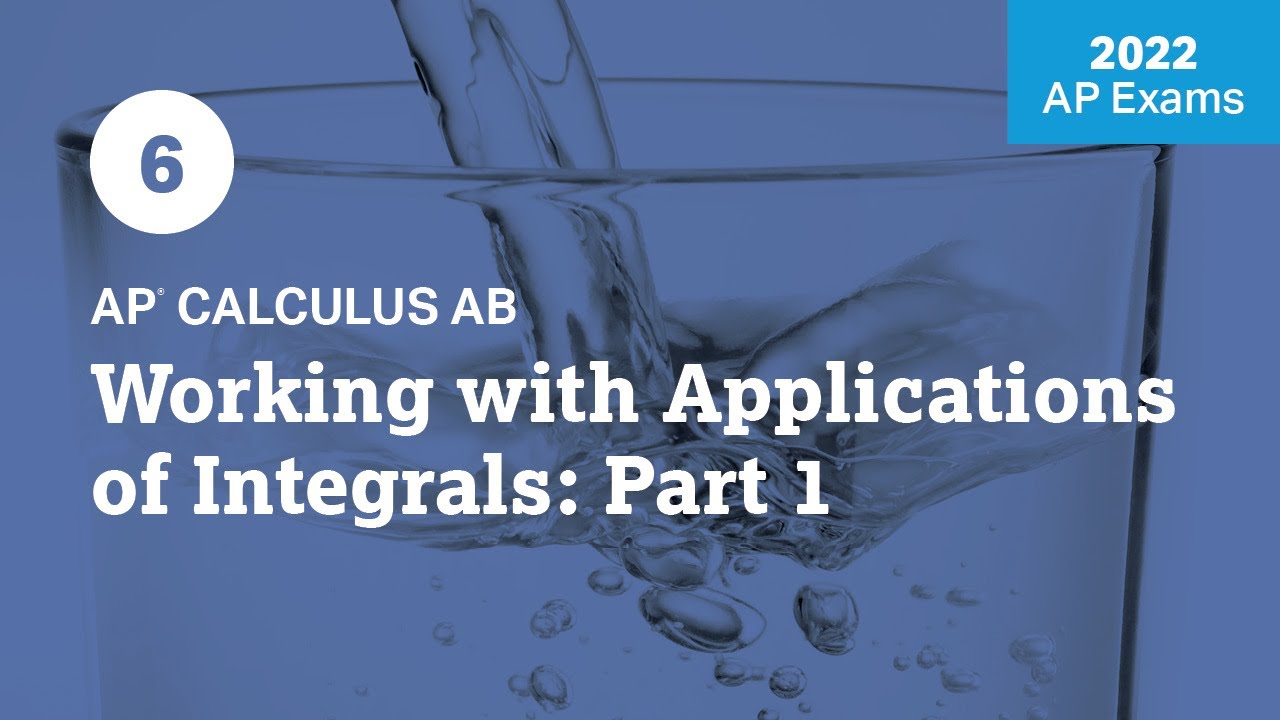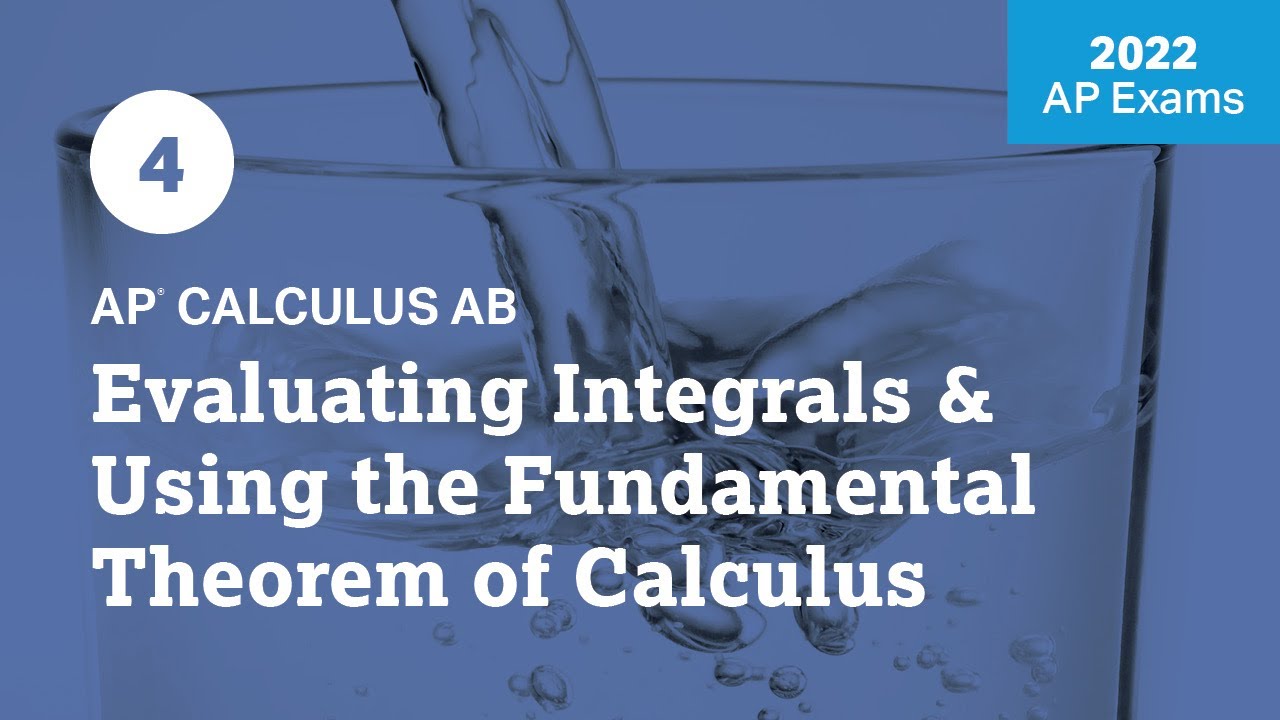AP Calculus Practice Exam Part 7 (FR #2-3)
TLDRIn this instructional video, the educator guides students through complex calculus problems involving integrals, derivatives, and average rates of change. They define and calculate the area under a curve, explore volume calculations through the washer method, and discuss the average value of a function. The script includes a mix of humor and pedagogy, emphasizing the importance of understanding calculus concepts and their applications. Despite some lighthearted moments, the focus remains on the mathematical processes and the challenges students may face in solving these problems, including the use of technology for complex integrals.
Takeaways
- 📚 The script involves a detailed walkthrough of a calculus problem, including integrals and derivatives.
- 🔍 It discusses how to define the area 'S' under a curve by using integration and the limits of integration.
- 📉 The process of breaking down a complex integral into simpler parts is explained, highlighting the use of integral properties.
- 📝 The importance of recognizing the functions involved in the integral and their corresponding areas is emphasized.
- 🧩 The script demonstrates how to calculate the volume of a solid formed by revolving a region around a line using the washer method.
- 🔢 The use of a calculator for complex integrals is shown, including the steps to input functions and operations correctly.
- 📈 The concept of average rate of change is covered, explaining how to find it between two points on a function.
- 📌 The derivative is used to find the slope of a tangent line to a curve at a specific point, which is a fundamental application of calculus.
- 📐 The script touches on the concept of piecewise functions and how to handle them when calculating integrals and derivatives.
- 📊 The problem-solving approach includes using technology (like graphing calculators or Desmos) to assist with complex calculations.
- 🎓 The educational context of the script is evident, with the speaker preparing students for an AP exam and providing teaching tips.
Q & A
What is the first step in finding the area represented by 'Area S' in the script?
-The first step is to define the integral for 'Area S'. It involves identifying the limits of integration and the functions that bound the area, which are f(x) and g(x), and then writing the integral as the subtraction of the two functions within those limits.
What integral property is used to split the area calculation into two separate integrals?
-The property of integrals that allows addition to be used, which in this case is applied to split the integral into two separate integrals that can be calculated individually.
How is the area of 'Area R' related to one of the integrals calculated in the script?
-The area of 'Area R' is directly given in the script, and it is found to be the same as one of the integrals calculated for the area between the curves f(x) and g(x) from 0 to 3.
What is the process for finding the volume of a solid formed by revolving 'Region S' around the line y = -3?
-The process involves using the washer method, which is an integral of the squared difference between the outer function f(x) + 3 and the inner function g(x) + 3, multiplied by the distance x from the axis of rotation, and then multiplied by π.
Why is the volume calculation for revolving 'Region S' around the line y = -3 more complex than revolving around the x-axis?
-The complexity arises because revolving around y = -3 introduces a hole in the middle of the solid (like a washer or donut shape), which requires adjusting the functions by adding 3 and squaring the results, unlike revolving around the x-axis where there is no hole.
What is the significance of the integral of f(x) from 0 to 3 in the context of the script?
-The integral of f(x) from 0 to 3 is significant as it represents the area under the curve f(x), which is a part of the process to find the volume of the solid formed by revolving 'Region S'.
What is the role of the constant π in the volume calculation for revolving 'Region S'?
-The constant π is a multiplicative factor in the integral that accounts for the circular cross-section of the solid when 'Region S' is revolved around the line y = -3.
How does the script differentiate between the concepts of integral calculus and derivative calculus?
-The script explains that integral calculus is used to find areas under curves and volumes of solids, while derivative calculus is used to find the rate of change or the slope of a tangent line to a curve at a specific point.
What is the average rate of change of a function on a given interval, and how is it calculated?
-The average rate of change of a function on a given interval is the change in the function's value (Δy) divided by the change in the independent variable (Δx). It is calculated by evaluating the function at the endpoints of the interval and then finding the difference between these values divided by the difference in the x-values.
What is the purpose of finding the derivative of a function in the context of the script?
-The purpose of finding the derivative of a function in the script is to determine the slope of the tangent line to the curve at a specific point, which is a fundamental concept in derivative calculus.
What is the average value of a function on a given interval, and how is it found?
-The average value of a function on a given interval is found by dividing the integral of the function over that interval by the length of the interval. It is represented by the formula (1/(b-a)) * ∫[f(x) dx] from a to b.
How does the script handle the complexity of a piecewise function when calculating the average value?
-The script handles the complexity of a piecewise function by splitting the integral into parts corresponding to the different sections of the piecewise function and then calculating the integral for each part separately.
What is the condition for a function to attain an absolute maximum on a closed interval, as mentioned in the script?
-A function attains an absolute maximum on a closed interval if it is continuous on that interval. This is determined by checking if the function's value is the same at the endpoints and at any points of discontinuity within the interval.
Outlines
📚 Calculus Problem Solving
This paragraph introduces a complex calculus problem involving the definition of area 'S' using integrals, with a focus on the properties of functions f(x) and g(x). The instructor guides students through identifying limits of integration and applying subtraction of functions to find the area under a curve. The use of integral properties to break down the problem into simpler integrals is also discussed, highlighting the process of finding the area of 'S' and relating it to known areas 'R' and 'T'.
🔍 Detailed Calculation of Area 'S'
The paragraph delves into the specifics of calculating the area 'S' by using a calculator to evaluate the integral of the function f(x) from 0 to 3. The process includes understanding the integral's components, such as the function's expression and the limits of integration. The instructor demonstrates how to input the integral into a calculator, emphasizing the importance of correct input to avoid errors. The result of the integral is then used to find the area of 'S' by subtracting the known area of 'R', leading to the final answer for part A of the problem.
📐 Volume Calculation Through Integration
The focus shifts to calculating the volume of a solid formed by revolving region 'S' around the line y = -3. The paragraph explains the concept of a washer method in calculus, which involves integrating the square of the functions f(x) and g(x), subtracting the latter from the former, and multiplying by π and x. The challenge of revolving around a non-axis line is highlighted, and the formula for the volume is reiterated. The paragraph also touches on the importance of understanding the geometric implications of revolving around different lines.
🤔 Troubleshooting Calculator Errors
This paragraph discusses the troubleshooting process when encountering a calculator error during the calculation of a complex integral. The instructor demonstrates how to identify and correct the mistake, ensuring that the integral is set up correctly with proper parentheses and squared terms. The goal is to accurately calculate the volume of the solid formed by revolving the region around the specified line, emphasizing the importance of careful input and checking calculations.
📈 Anti-Derivative and Integral Calculation
The paragraph covers the process of finding the anti-derivative of a function and using it to evaluate the definite integral from 0 to 3. The instructor explains the concept of anti-derivatives and how to apply them to calculate the volume of a solid, which involves integrating a function and then evaluating it at the given limits. The paragraph also discusses the simplification of integrals with constants and the application of the results to find the volume of the solid described in the problem.
📝 Writing an Integral for Solid Volume
The paragraph discusses the process of writing an integral to calculate the volume of a solid with a base region 'S', where each cross-section perpendicular to the x-axis is a rectangle. The solid's volume is found by integrating the function representing the height of these rectangles, multiplied by the length of the base and π. The paragraph emphasizes the importance of understanding the geometric properties of the solid and the function that describes it to set up the integral correctly.
🔢 Average Rate of Change Calculation
This paragraph explains how to calculate the average rate of change of a function on a given interval without a calculator. The method involves finding the change in y-values and dividing it by the change in x-values over the specified interval. The instructor provides a step-by-step guide on evaluating the function at the interval's endpoints and performing the necessary arithmetic to find the average rate of change, which is a fundamental concept in calculus.
📉 Derivative and Tangent Line Equation
The paragraph focuses on the concept of derivatives in calculus and their application in finding the equation of a tangent line to a curve at a specific point. The instructor explains the process of finding the derivative of a function, evaluating it at a given x-value, and using this to determine the slope of the tangent line. The importance of understanding the derivative as the rate of change and its role in describing the instantaneous slope of a curve is emphasized.
🧩 Average Value of a Function
This paragraph discusses the concept of the average value of a function over an interval and how to calculate it using the integral. The instructor explains the formula for the average value and how to apply it to a piecewise function, which requires splitting the integral into parts corresponding to different segments of the function. The paragraph highlights the challenges of working with piecewise functions and the importance of understanding their properties to perform the calculation correctly.
📉 Derivative Calculation for Tangent Line
The paragraph delves into the specifics of calculating the derivative of a function to find the slope of the tangent line at a given point. The instructor demonstrates the use of the chain rule and the process of evaluating the derivative at a specific x-value. The importance of correctly applying calculus rules to find the derivative and subsequently the slope of the tangent line is emphasized.
📈 Desmos Graphing and Area Under the Curve
This paragraph discusses the use of Desmos, an online graphing calculator, to visualize the area under a curve and solve calculus problems. The instructor uses Desmos to graph a function and identify the area under the curve between specific limits. The paragraph explains how to describe the shape of the area under the curve and how to calculate its size using geometric knowledge, such as recognizing a quarter of a circle and calculating its area.
🔍 Absolute Maximum on a Closed Interval
The final paragraph addresses the question of whether there is a value of x for which the function attains an absolute maximum on a closed interval. The instructor explains that this is possible if the function is continuous over the interval. The process involves checking the value of the function at the endpoints and any critical points within the interval. The paragraph concludes with a confirmation that the function in question is continuous and therefore attains an absolute maximum on the given interval.
Mindmap
Keywords
💡Integral
💡Limits of Integration
💡Trigonometric Functions
💡Derivative
💡Average Rate of Change
💡Piecewise Function
💡Volume of a Solid
💡Washer Method
💡Anti-Derivative
💡Continuity
Highlights
Introduction to a calculator-based question involving an interesting function with trigonometric components.
Explanation of defining the area 'S' using integrals and the importance of identifying limits of integration.
Use of integral properties to break down complex integrals into simpler parts.
Identification of the area 'R' and its relation to the integral from 0 to 3 of G(x)dx.
Demonstration of using a calculator to find the area under the curve for part A of the question.
Clarification on the difference between finding the area under a curve and the slope of a tangent line in calculus.
Introduction to the volume calculation involving the washer method for a solid of revolution.
Explanation of the complexities added by revolving around a line other than the x-axis in the volume calculation.
Step-by-step guide on setting up the integral for the volume of a solid created by revolving region 'S'.
Misstep in calculator input and the process of troubleshooting errors during calculations.
The use of algebraic expansion and simplification in setting up integrals for volume calculations.
Utilization of given values for areas 'R' and 'T' to simplify the volume calculation.
Final calculation of the volume using the washer method and the importance of constants in integrals.
Transition to non-calculator-based questions and the importance of understanding piecewise functions.
Discussion on finding the average rate of change of a function over an interval.
Explanation of the process to find the equation of a tangent line to a curve at a specific point.
Challenge of calculating the average value of a piecewise function over a specific interval.
Admission of difficulty in manually calculating certain integrals without technology.
Use of technology to find the area under a curve and the importance of understanding the shape of the graph.
Conclusion on the continuity of a function and the conditions for a function to attain an absolute maximum.
Transcripts
Browse More Related Video

2022 Live Review 6 | AP Calculus AB | Working with Applications of Integrals: Part 1

2022 Live Review 4 | AP Calculus AB | Integrals & Using the Fundamental Theorem of Calculus

Fall 2023 MNC: Slice thin and add - Riemann sums and definite integrals

Math Test Practice Test [ 30 Minutes ] Math for Business and Economics

Calc BC 2022 FRQs 1-6 Compilation

It All Adds Up: Accumulation Problems
5.0 / 5 (0 votes)
Thanks for rating: